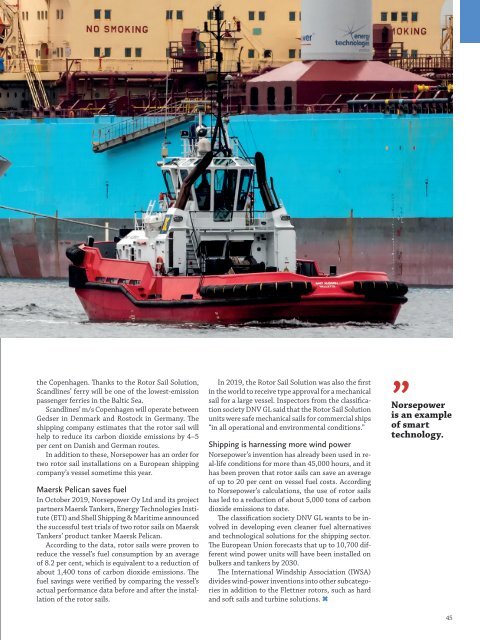Create successful ePaper yourself
Turn your PDF publications into a flip-book with our unique Google optimized e-Paper software.
the Copenhagen. Thanks to the Rotor Sail Solution,<br />
Scandlines’ ferry will be one of the lowest-emission<br />
passenger ferries in the Baltic Sea.<br />
Scandlines’ m/s Copenhagen will operate between<br />
Gedser in Denmark and Rostock in Germany. The<br />
shipping company estimates that the rotor sail will<br />
help to reduce its carbon dioxide emissions by 4–5<br />
per cent on Danish and German routes.<br />
In addition to these, Norsepower has an order for<br />
two rotor sail installations on a European shipping<br />
company’s vessel sometime this year.<br />
Maersk Pelican saves fuel<br />
In October 2019, Norsepower Oy Ltd and its project<br />
partners Maersk Tankers, Energy Technologies Institute<br />
(ETI) and Shell Shipping & <strong>Maritime</strong> announced<br />
the successful test trials of two rotor sails on Maersk<br />
Tankers’ product tanker Maersk Pelican.<br />
According to the data, rotor sails were proven to<br />
reduce the vessel’s fuel consumption by an average<br />
of 8.2 per cent, which is equivalent to a reduction of<br />
about 1,400 tons of carbon dioxide emissions. The<br />
fuel savings were verified by comparing the vessel’s<br />
actual performance data before and after the installation<br />
of the rotor sails.<br />
In 2019, the Rotor Sail Solution was also the first<br />
in the world to receive type approval for a mechanical<br />
sail for a large vessel. Inspectors from the classification<br />
society DNV GL said that the Rotor Sail Solution<br />
units were safe mechanical sails for commercial ships<br />
“in all operational and environmental conditions.”<br />
Shipping is harnessing more wind power<br />
Norsepower’s invention has already been used in real-life<br />
conditions for more than 45,000 hours, and it<br />
has been proven that rotor sails can save an average<br />
of up to 20 per cent on vessel fuel costs. According<br />
to Norsepower’s calculations, the use of rotor sails<br />
has led to a reduction of about 5,000 tons of carbon<br />
dioxide emissions to date.<br />
The classification society DNV GL wants to be involved<br />
in developing even cleaner fuel alternatives<br />
and technological solutions for the shipping sector.<br />
The European Union forecasts that up to 10,700 different<br />
wind power units will have been installed on<br />
bulkers and tankers by 2030.<br />
The International Windship Association (IWSA)<br />
divides wind-power inventions into other subcategories<br />
in addition to the Flettner rotors, such as hard<br />
and soft sails and turbine solutions. ✖<br />
” Norsepower<br />
is an example<br />
of smart<br />
technology.<br />
45

















